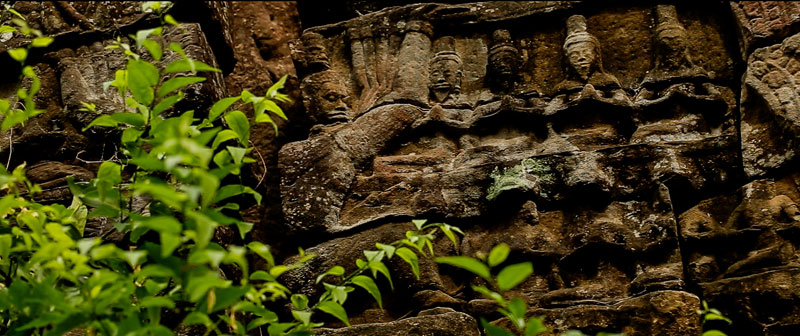The short film “What if the Stones Could Speak,” shown at Bophana Center Saturday afternoon, could be described as a cry from the heart on behalf of historical monuments in the country.
In this 8:35-minute work, damaged sculptures and bas-reliefs of great beauty fill the screen, shown in close-ups in their settings of luxuriant vegetation. No dialogue interferes with their message, the only soundtrack being melancholy music.

Shot and edited in February, the film was done by filmmaker Makara Ouch. During a visit to Banteay Meanchey province last year as film producer for the Documentation Center of Cambodia, he was appalled by the state of the Banteay Chhmar monument located next to Banteay Chhmar Khang Choeung village.
“I thought, wow, it’s almost collapsed,” Mr. Ouch said. “Some statues have no head anymore” and sections of the monuments now amount to a pile of stones, he said.
Banteay Chhmar was built 800 years ago at the height of the Angkorian empire. “As a sanctuary, it must have rivaled Angkor Wat for first place in size and magnificence,” U.S. researcher Lawrence Palmer Briggs wrote in 1949. At Cambodia’s request, it was put on the Tentative List for World Heritage Sites in 1992.
Located near the Thai-Cambodian border, the monument was prey to looters big and small in the 1990s and 2000s. This went as far as hacking huge chunks of wall off its western gallery, an operation that required heavy equipment and trucks for transport.
Today, Banteay Chhmar is being restored by the Global Heritage Fund in cooperation with the Ministry of Culture.
But salvaging a monument that spreads over 12 square km is a gigantic task and, while emergency work is being done, some parts of the monument are left to fend for themselves.
“That’s why I thought if the stones could speak, they would tell…their own people how they feel, how they have survived, what they have been through,” the 25-year-old filmmaker said. “They are Khmer treasures.”
In the film, he has interspersed shots of the monuments with close-ups of nearby villagers, proving in the process that the people living in the vicinity and those immortalized in the sculpted scenes of Banteay Chhmar are the same. “But their own people have sold them for money. It hurts: If the stones could speak, they would tell their pain,” Mr. Ouch said.
Mr. Ouch, who was the cameraman for the film, used only natural light as he tried to reflect in the film the beauty and peacefulness of the setting.
He hopes to turn this into a full-length documentary to make the case for Cambodian heritage preservation.



